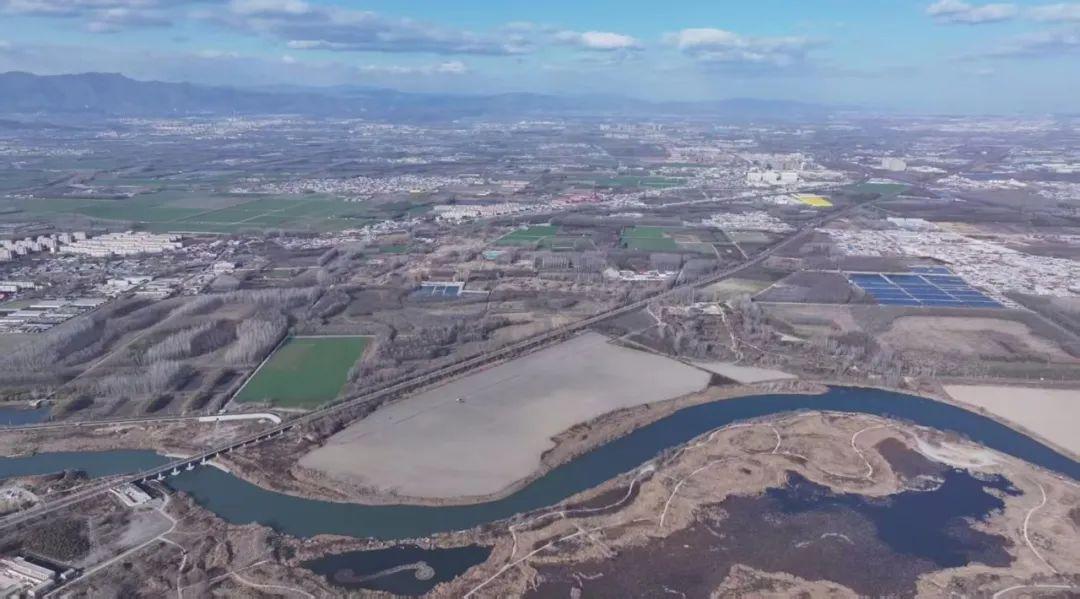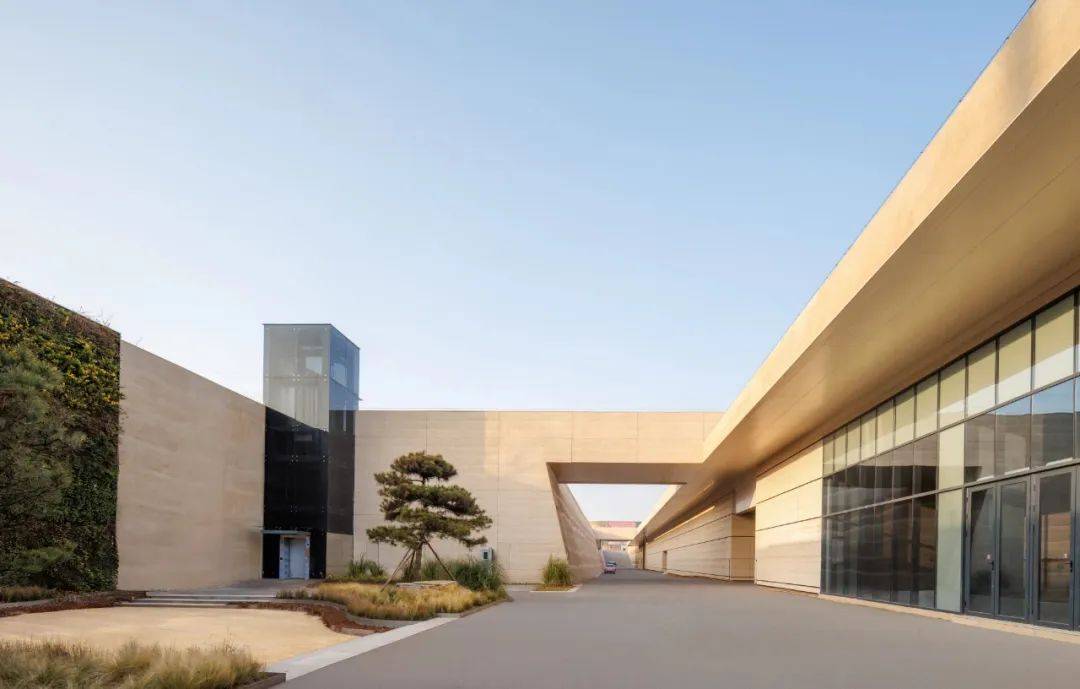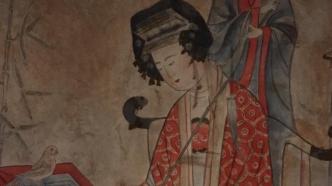
"There are beauties in the north - the Liao Dynasty Women's Cultural Relics Exhibition of the Inner Mongolia Autonomous Region Cultural Relics and Archaeology Research Institute" (March 30-June 30) is on display at the Suzhou Museum. Different from previous Liao Dynasty cultural relics exhibitions, this exhibition focuses on Khitan women, especially aristocratic women of the Liao Dynasty. Through exquisite cultural relics of different textures and types such as gold and silver wares, jade, lacquerware, amber, and glass, it presents the broad-mindedness and self-confidence and heroism of northern nomadic women who "bend the bow and hunt is their nature" and "wherever horses and cattle are at home". This is the first time in the history of Khitan Liao Dynasty cultural relics exhibitions in China that the theme is Khitan Liao Dynasty women.
The cultural relics in these exhibitions are all from the Inner Mongolia Autonomous Region Cultural Relics and Archaeology Research Institute. Sun Jinsong, director of the Inner Mongolia Autonomous Region Cultural Relics and Archaeology Research Institute, recently accepted an interview with The Paper on topics such as why a special exhibition was used to focus on Liao Dynasty women and how to give full play to the unique role of archaeological evidence in promoting the research and construction of northern Xinjiang culture.

"There are beauties in the north - the Liao Dynasty female cultural relics exhibition of the Inner Mongolia Autonomous Region Cultural Relics and Archaeology Research Institute"
The Paper: Currently, the "Beauty in the North - Liao Dynasty Women's Cultural Relics Exhibition of the Inner Mongolia Autonomous Region Cultural Relics and Archaeology Research Institute" is on display at the Suzhou Museum. The exhibition presents more than 100 pieces (sets) of cultural relics in various categories, including gold, silver, bronze, jade, etc., of which more than half are first-class cultural relics. So many exquisite cultural relics have come from the grassland to the south of the Yangtze River. Could you please introduce the origin and curatorial process of the joint planning of this exhibition by the Inner Mongolia Autonomous Region Cultural Relics and Archaeology Research Institute and Suzhou Museum?
Sun Jinsong: In 2022, Suzhou Museum used the name "Beauty's Surname is Dong" and in 2023 it used the name "Leaving Luxiang Garden" to deeply explore the stories behind the cultural relics from the perspective of women's history. In the summer of 2023, the Suzhou Museum team came to our institute for field research and investigation. The two sides reached a consensus that our institute and Suzhou Museum would jointly plan and host the special exhibition "There is a Beauty in the North". Suzhou Museum will serve as the exhibition introduction and display unit, and our institute will provide all the exhibition cultural relics. The entire exhibition work, from the early preparation, planning, outline writing, exhibition design, cultural relics screening, cultural relics photography, catalog compilation, on-site exhibition and other work, was jointly finalized by both parties and they undertook their respective tasks. It can be said that this exhibition is a strong combination of the Institute of Archaeology and the museum. The two sides have a clear division of labor and each exhibits its strengths, realizing the intelligent collision of the excavation of the connotation of unearthed cultural relics and the revitalization and display of them.
In fact, as one of the important birthplaces of Chinese civilization, Inner Mongolia has a diverse culture and unique cultural relics. Over the past 70 years, after the continuous efforts of several generations of archaeologists, many major new archaeological discoveries and research results have been made, and the cultural relics are rich.
The Sixth Plenary Session of the 11th Inner Mongolia Autonomous Region Party Committee put forward the requirement to establish a brand for the culture of the northern border. The "Decision of the Inner Mongolia Autonomous Region Party Committee on Building a Model Autonomous Region in All Directions" made a comprehensive deployment for the construction of the culture of the northern border. The culture of the northern border covers all cultures in the Inner Mongolia region, integrating red culture with grassland culture, farming culture, Yellow River culture, and Great Wall culture. Its basic content is the communication, exchange, and integration of all ethnic groups, mutual assistance, and the common promotion of the Mongolian horse spirit and the "Three North Spirits", and the establishment of a strong sense of community for the Chinese nation. The Inner Mongolia Autonomous Region Cultural Relics and Archaeology Research Institute actively responded to the work requirements of the Party Committee and Government of the Autonomous Region. Under the guidance and support of the Inner Mongolia Autonomous Region Department of Culture and Tourism and the Autonomous Region Cultural Relics Bureau, it strengthened its responsibility and carried out in-depth research on the culture of the northern border.

Sun Jinsong, director of the Inner Mongolia Autonomous Region Cultural Relics and Archaeology Research Institute, at the "Beauties in the North - Exhibition of Liao Dynasty Female Cultural Relics of the Inner Mongolia Autonomous Region Cultural Relics and Archaeology Research Institute"
In terms of research, display and utilization of cultural relics, our institute follows the working model of "excavating, protecting, researching, displaying and promoting at the same time" and, based on the actual situation of archaeological and cultural relics work, actively participates in special exhibitions of archaeological results in and outside the region, using archaeologically unearthed cultural relics to demonstrate the contribution of northern border culture to the formation of Chinese history and the development of the integration of multi-ethnic cultures.
Up to now, our institute has carried out more than 100 precious cultural relics exchange and exhibition cooperation with dozens of museums at home and abroad, allowing more cultural relics to come out of the warehouse and go on display, allowing precious historical and cultural heritage to shine with the glory of the times and radiate the vitality of the times.

The "Li Family Offering" bronze mirror exhibited in the "Beauties in the North - Liao Dynasty Female Cultural Relics Exhibition of the Inner Mongolia Autonomous Region Cultural Relics and Archaeology Research Institute" was unearthed from the Liao Dynasty Tomb in Turgi Mountain, Horqin Left Wing Rear Banner in 2003
The Paper: There are many Liao tombs in Inner Mongolia. Among the 10 "Top Ten Archaeological Discoveries in China" awarded in the Inner Mongolia Autonomous Region, 4 are Liao tombs. Could you please introduce the important archaeological discoveries and research on Liao tombs since the establishment of the Inner Mongolia Autonomous Region Cultural Relics and Archaeology Research Institute?
Sun Jinsong: So far, more than a thousand Liao Dynasty tombs have been excavated across the country. The most famous Liao tombs excavated by our institute are the Princess Chen Tomb in 1986, the Tomb of Yelu Yuzhi in 1992, the Baoshan Liao Tomb in 1994, the Turgishan Liao Tomb in 2003, and the Tomb of the Concubine of Emperor Shengzong of Liao in 2015. In addition, the Han Family Tomb, the Maiwanggou Liao Tomb, the Xiaoliu Zhangzi Liao Tomb, etc. have also greatly enriched our understanding of the Khitan-Liao. These materials cover the early to late Liao Dynasty, and the unearthed cultural relics include ceramics, copper, iron, gold, jade, glass, agate, amber, etc. The materials are rich and the sequence is complete. Sufficient archaeological data have made up for the lack of historical records and strongly promoted the study of Liao history. The archaeological periodization of the Liao Dynasty has been established, the typological research of Liao tombs has been clear, and the special research on Liao Dynasty porcelain, gold and silver wares, murals, clothing, horse gear, etc. has achieved fruitful results. Khitan large and small characters, Khitan ethnic origin, ethnology, anthropology and other multidisciplinary cooperation have reached a new level.
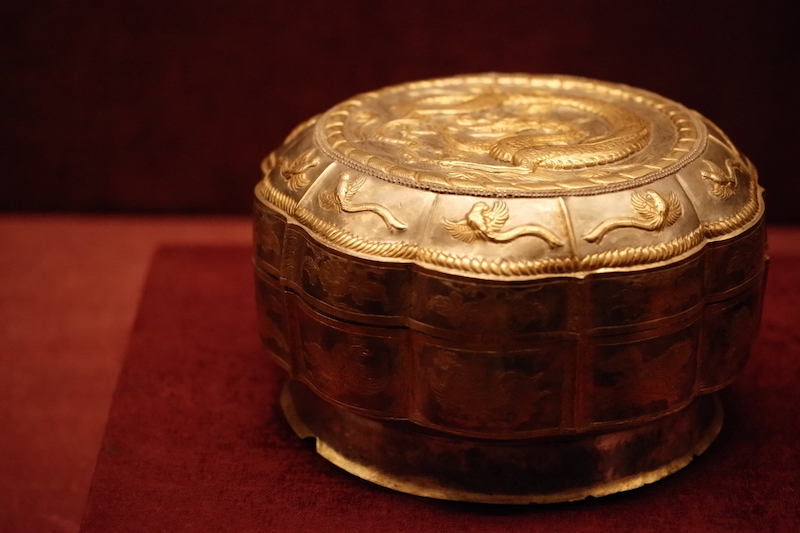
Silver box with dragon pattern and golden flowers exhibited in "There are beauties in the north - Liao Dynasty female cultural relics exhibition of the Inner Mongolia Autonomous Region Cultural Relics and Archaeology Research Institute" was unearthed from the Liao Dynasty tomb in Turgishan, Horqin Left Wing Rear Banner in 2003
In recent years, the focus of Liao Dynasty archaeological work has been on the excavation and research of city sites. Archaeological excavations of cities such as Liao Shangjing and Wu'anzhou have both difficulties and innovations, and are promoted through multiple disciplines. We look forward to the announcement of further research results.
The Paper: This exhibition focuses on Khitan women for the first time, giving us the opportunity to glimpse the daily lives of Liao women through unearthed cultural relics. So what was the status of women in Liao society as a whole? What important influence did they have on the rise of the Khitan?
Sun Jinsong: Since ancient times, women in northern ethnic groups have had a high social status. The Khitan and Mongolian peoples we are familiar with attach great importance to the power of women, especially the maternal clan and mothers, who have a strong voice in politics and life. For example, Shulü Ping, the descendant of Yelü Abaoji in the early Khitan period, was brave and resourceful. She first assisted Abaoji and then masterminded the dethronement and enthronement of the new emperor, and held military and political power for many years; the Khitan Queen Mother Xiao Yanyan was brave and decisive, and her name was known throughout history.
Archaeological data show that the ancients treated death as life. Because of the different division of labor between men and women in the Khitan Liao, there were differences in the burial objects of men and women in tombs. Women had more jewelry and ornaments and other daily necessities, while men had more weapons, tools, carriages and utensils. The scale of the tomb and the number and type of burial objects reflect the difference in class, but it is generally determined by the difference in social class of the tomb owner during his lifetime, rather than by gender. From the burial objects, Khitan women played a very important role in social life. Take the owner of the Turki Mountain Tomb as an example. She was a noble woman such as a princess, but she was not a princess in the inner room who lived a life of luxury and never left the house. From the unearthed copper horns, sun and moon-shaped gold and silver plaques and other objects, it is speculated that she may be a shaman. From the high-footed glass cups, jade-inlaid lacquerware and other objects, she learned from many people and had high cultural and artistic attainments and aesthetic tastes. Although the Princess of Chen was only 18 years old, judging from the bow bag and two complete sets of horse harnesses buried with her, the princess was not only good at playing the zither, but also able to gallop on the battlefield and travel the world with her husband.

A gold-plated and silver-studded belt (partial) exhibited in the "Beautiful Women in the North - Exhibition of Liao Dynasty Female Cultural Relics by the Inner Mongolia Autonomous Region Cultural Relics and Archaeology Research Institute" was unearthed from the joint tomb of Princess Chen and her husband in Naiman Banner, Tongliao City in 1986
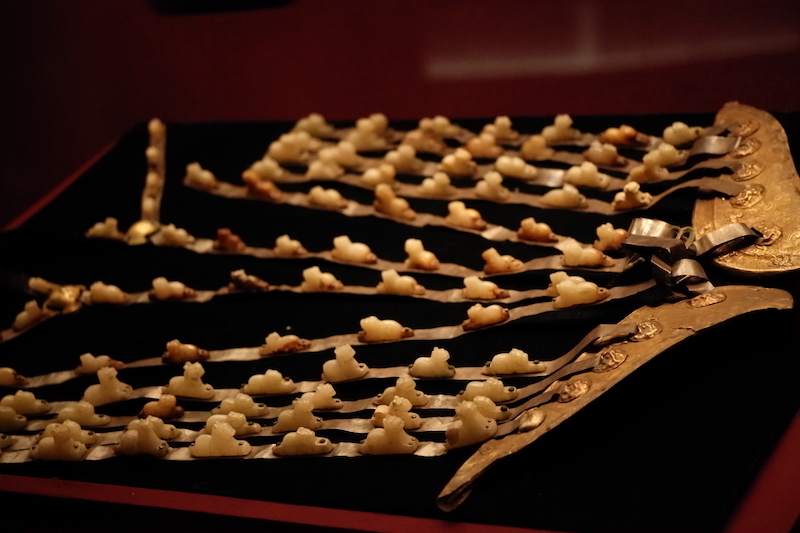
The jade-inlaid silver-strap belt and silver-strap belt on display at the "Beauties in the North - Exhibition of Liao Dynasty Women's Cultural Relics by the Inner Mongolia Autonomous Region Cultural Relics and Archaeology Institute" were unearthed from the joint tomb of Princess Chen and her husband in Naiman Banner, Tongliao City in 1986
From the "History of Liao" and "History of Khitan", another manifestation of the high status of Khitan women is that women have their own property at their disposal in the family, such as funding the construction of Buddhist temples and pagodas. In terms of laws and policies, the government provides the same protection and encouragement for filial piety to mothers and fathers. The government provides pensions to lonely old women and widows of martyrs, and protects and rewards elderly women and widows.
Khitan women have the tenacity of the grassland peoples as well as the intelligence and delicacy unique to women. They are able to take on responsibilities as daughters, sisters, mothers and wives, which plays an important role in shaping the Khitan people's tolerant, open and brave national character.
The Paper: In this exhibition, we saw two exquisite murals unearthed from Liao tombs. Could you please introduce the current status of mural archaeological excavation and preservation in Inner Mongolia? Why are most of the murals we see now copies?
Sun Jinsong: The murals unearthed in Inner Mongolia mainly come from the Eastern Han Dynasty, Liao Dynasty and Yuan Dynasty, with the Liao Dynasty being the main ones. So far, about 50 batches of mural tombs have been excavated.
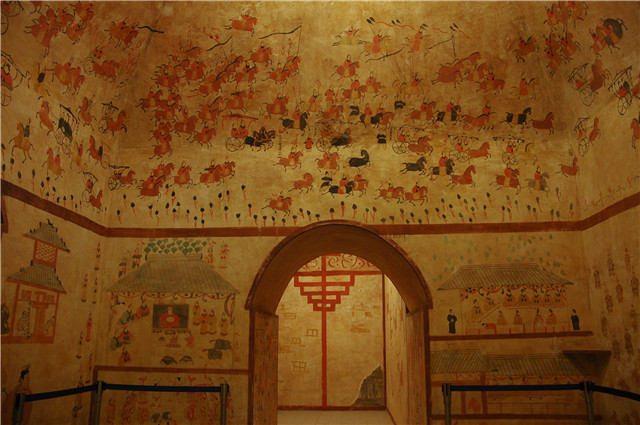
The murals of Xiaobanshen in Horqin
Among them, the most famous Eastern Han Dynasty murals are the Xiaobanshen murals in Horqin, and others include the Milanhao murals in Otog Banner, Ordos, the Fenghuangshan murals in Otog Banner, and the Garutu murals in Wushen Banner. The contents are pavilions, hunting, travel, social life, ethnic relations, and cultural exchanges. They are basically preserved in their original locations.

Mural painting of the Liao Dynasty tombs in Lamagou: Preparation for Spring Hunting
The murals of Liao Dynasty are divided into three periods: early, middle and late. The early murals include the murals of Baoshan Liao Tomb in Alukeerqin Banner and the murals of Turqishan Liao Tomb (most of them have fallen off, and some fragments have been restored and transferred to Inner Mongolia Museum by the Institute of Archaeology). The middle murals include the tomb of Princess Chenguo in Naiman Banner, Tongliao, and the Eastern Tomb of Liaoqing Mausoleum (Shengzong Mausoleum) in Balin Right Banner. The contents are mainly landscapes, portraits, carriages and horses, slaves and guards, etc. The late murals include the tomb of Yelu Hongshi in the Eastern Tomb of Qing Mausoleum (the murals were removed, and there are 12 murals in our institute), the Liao Tomb in Lamagou (removed and stored in Aohan Banner Museum), and the Liao Tomb No. 1 in Pijianggou (removed and stored in Aohan Banner Museum). The contents are mainly the tomb owner's hunting trips, flowers, birds, lakes and stones, banquets, music, camel carts and carriages, etc.
Few murals from the Yuan Dynasty have been discovered, mainly in small and medium-sized tombs of nobles or officials, with realistic contents, such as offering tea and wine, couples sitting together, going out hunting, etc. In addition, murals discovered from other eras include the Five Dynasties mural tombs in Tarliang, Qingshuihe, and the Xixia mural tombs in Jungar Banner.
Our institute currently has 12 murals unearthed from the tomb of Yelu Hongshi. In 2013, we cooperated with the Inner Mongolia Museum and the Kyushu Museum in Japan to conduct 3D scanning of the murals unearthed from the tomb of Yelu Hongshi. In 2014, we cooperated with the Dunhuang Research Institute to conduct scientific and technological testing on these murals. In May 2019, the working group of the Key Scientific Research Base for the Protection and Restoration of the Murals in the Collection of the Shaanxi History Museum investigated the preservation of the murals in our institute and carried out cooperation. Our institute became a workstation of the scientific research base.
As one of the four workstations in the northwest provinces of the National Cultural Heritage Administration's key scientific research base for the protection, restoration and material science research of the murals in the collection, the Inner Mongolia Autonomous Region Cultural Relics and Archaeology Research Institute will deepen cooperation and expand its influence in the future. The murals unearthed in archaeological excavations are accidental. During the excavation work, if a mural tomb is discovered, contact the base in time to request technical, personnel and equipment support, hoping to achieve on-site reinforcement and protection and removal.
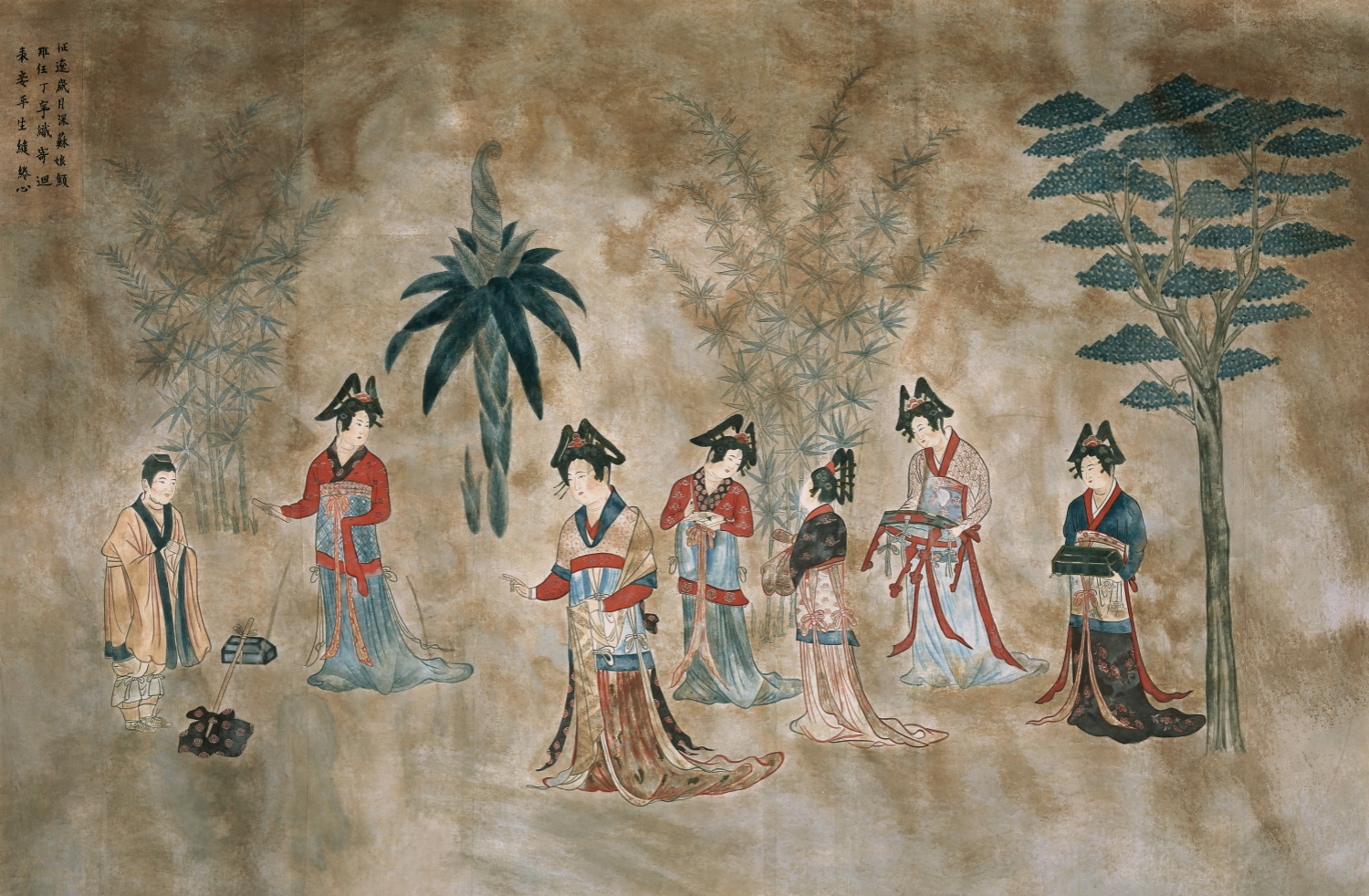
Sending Brocade (copy)
The tomb murals excavated in the 1980s and 1990s, such as the Tomb of Princess Chen and the Liao Tomb in Baoshan, were mostly rescue archaeological excavations. Time was tight, and due to the limited manpower, material resources, time, and protection technology at the time, most of the murals were photographed and copied in cooperation with scientific research institutions, and basic information was extracted before being preserved in situ. Since the 21st century, the scientific and technological means of mural protection have been constantly innovated. We have continuously strengthened cooperation with scientific research institutions inside and outside the district. In recent years, we have unearthed murals and adopted overall packaging and laboratory restoration technology to scientifically extract and maintain the murals.
The Paper: In addition to the Khitan Liao Tombs, what other important new archaeological discoveries have been made in the Inner Mongolia Autonomous Region in the past five years?
Sun Jinsong: (I) The major projects of "Exploring the Origin of Chinese Civilization" and "Archaeology of China" have achieved fruitful results. First, we will continue to promote "Archaeology of China - Research on the Process of Social Civilization in Hongshan". The numerous early Bronze Age remains discovered in the upper reaches of Liuhe River demonstrate the rapid development of the social civilization process in the Xiliaohe River Basin in the early Bronze Age of the post-Hongshan culture. The archaeological excavation of the Caitaopo site has achieved phased results. The unearthed dragon-shaped clam decorations confirm the universality of the "dragon" belief of the ancestors of the Hongshan culture, and also lay a solid foundation for the application of the Hongshan culture for World Heritage. Second, we will continue to carry out the archaeological excavation of Houchengzui Stone City under the "Archaeology of China - Research on Settlements and Society in the Hetao Region". More than 20 high-level building complexes and underground passages composed of linked house sites, courtyards, and stone slope protection platforms in the Longshan era have been newly discovered, which are of great significance for exploring the civilization process in the Hetao region, the establishment of early cities in northern China, and the exchange and integration of archaeological cultures between central and southern Inner Mongolia and the Central Plains.
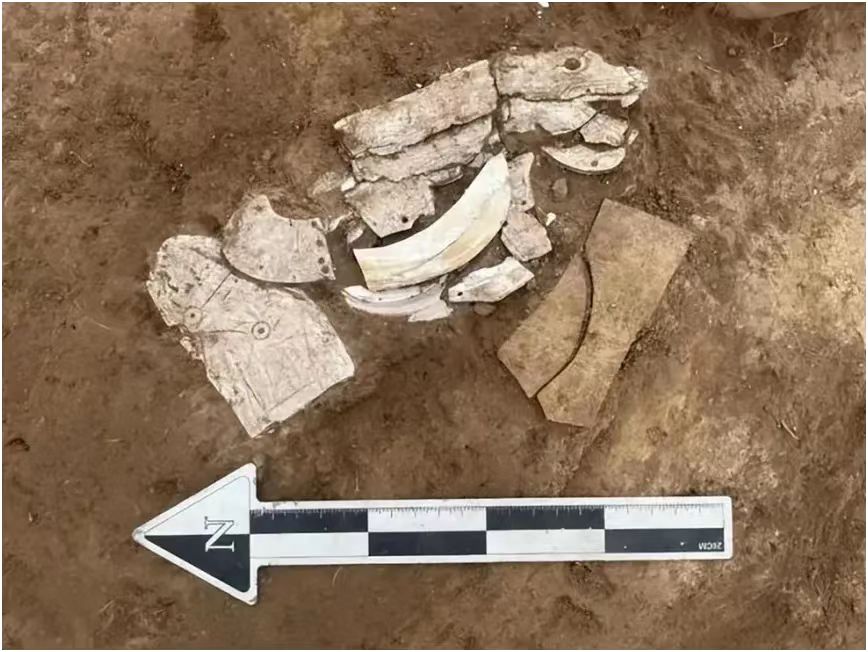
Dragon-shaped clam ornaments unearthed from the Caitaopo site
(II) The special project of "implementing the important instructions and instructions of General Secretary Xi Jinping on grottoes and temples" has been further promoted. First, the surveying and mapping work of 36 grottoes and temples in 8 leagues and cities, including Hohhot, Alxa, Bayannur, Baotou, Ordos, Chifeng, Tongliao, and Xilin Gol League, has been completed. Second, the archaeological excavation and data collation of the top building ruins of the Alzhai Grottoes in Etuoke Banner have been completed, especially the foundation of Building No. 4 of the Alzhai Grottoes, which has a large scale and regular layout. The unearthed components are exquisitely crafted and beautifully decorated, revealing a profound architectural historical and cultural heritage.
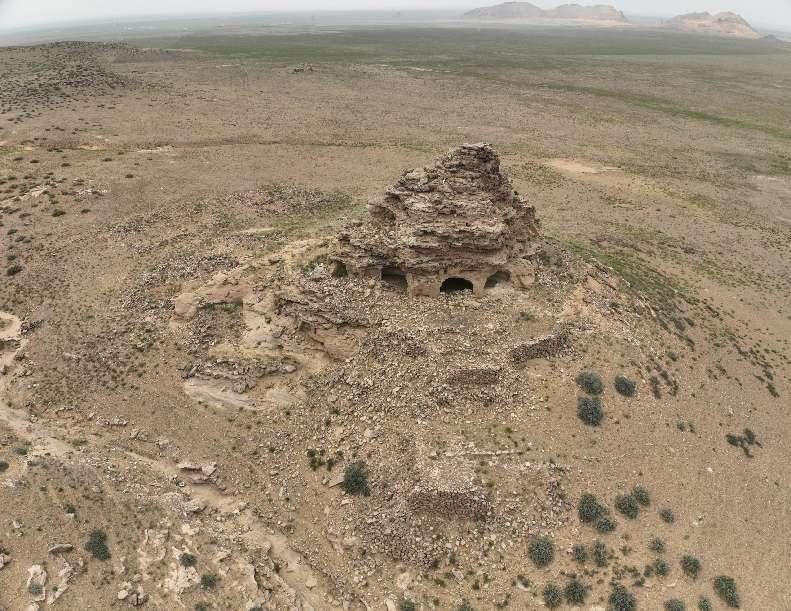
Investigation found the ruins of the cave temple

Great Wall Relics
(III) The special project of archaeological interpretation of "Northern Xinjiang Culture" has achieved rich results. First, the investigation and research work of the Great Wall in Alxa League, Ulanqab City and Hohhot City was completed. Participated in the preparation of the "Medium- and Long-term Work Plan for Great Wall Archaeology" of the State Administration of Cultural Heritage, and started the compilation of the "Five-Year Plan for Inner Mongolia Great Wall Archaeology". Second, a total of 16 tombs were excavated in the Jihulangtu Xiongnu Tomb Group in Sunite Right Banner, and the acceptance work for this year was completed. And the relevant unearthed samples extracted and collected were scientifically analyzed. Third, the archaeological excavation briefing report of the Northern Wei sacrificial building site on the top of the dam was completed. Fourth, on the basis of carrying out field archaeological excavations, the first field archaeological practice training class was held at the Xiliujiatun site, which was a useful exploration for the construction of cultural relics and archaeological talents in our region, and it was of great significance for in-depth research on the layout structure, production mode and social organization structure of the Xinglongwa culture settlement during the Xinglongwa culture period. Fifth, the archaeological excavation of the ancient city gate site of Wu'anzhou was completed, and the exploration of the city site layout was carried out in an orderly manner. Sixth, the completion of the excavation of the Sharitala site is of great value in filling in the cultural sequence from the late Neolithic period to the Shang and Zhou dynasties in the central and southern Inner Mongolia, exploring the early differentiation of agriculture and animal husbandry, and the movement of people and cultural exchanges between the north and the south.
(IV) The special project on the study of early human origins in East Asia has been fully promoted. First, the excavation of the Salawusu site has been basically completed, and the original site a hundred years ago has been clearly found, which has completely clarified historical doubts. Two new native cultural layers containing human relics have been discovered. The whole process of "excavation-protection-display" of the Paleolithic site has been realized. Second, the Jinstai site fully displays the chronological sequence from about 40,000 to 3,000 years ago, providing important clues for reconstructing the formation process of the site, restoring the production and living behaviors of ancient humans, and exploring the relationship between the environment and human evolution.
(V) The application of the “Tea Horse Road” for World Heritage status is progressing in an orderly manner.
The Paper: In the archaeological excavation of prehistoric civilizations in the Hetao region of Inner Mongolia, the Houchengzui Stone City Site was included in the "Archaeology China" list of important archaeological discoveries of the Neolithic Age released by the State Administration of Cultural Heritage, and was selected as a candidate for the final review of the top ten archaeological discoveries in the country in 2023. What is the significance of the archaeological excavation of this stone city site?
Sun Jinsong: From 2019 to 2023, the Inner Mongolia Autonomous Region Institute of Cultural Relics and Archaeology has carried out continuous archaeological excavations to systematically promote the implementation of the project "Archaeology China-Study on Settlements and Society in the Hetao Region". A total of 5,000 square meters have been excavated so far, revealing more than 50 relics such as city walls, city gates, mamian, platforms, piers, trenches, underground passages, tombs, and house sites. Jade, pottery, stone, bone and other relics have been unearthed, clarifying the basic forms of the Houchengzui Stone City's triple defense system, underground passage system, high-level building complex, and burial area, providing solid and reliable physical data for exploring the process of social complexity in the Longshan period in the Hetao region and the origins of ancient Chinese urban construction, especially the development and changes of the city defense system.

Panoramic view of Houchengzui Stone City
Houchengzui Stone City consists of a triple defense system built with three city walls and ancillary buildings, and an underground transportation system of "open ditches and hidden passages" constructed with double urn city structures, moats and underground passages. Together, they form the most rigorous and complete three-dimensional city defense system above and below the ground in Houchengzui Stone City, which is the first discovery in the field of prehistoric archaeology.
The 1.38 million square meters of land area, the extremely complex defense system, the high-level building base similar to the Shimao Imperial City Terrace, the high-level building complex similar to the "Palace City" of Lushanmao, the unearthed jade bi, jade huang, jade knives, etc., and the typical pottery of the early Longshan period such as wide-crotch li, closed-mouth he, and jia have confirmed that Houchengzui Shicheng is the central city site of the early Longshan period in the Hetao area, providing extremely important archaeological materials for exploring the process of social complexity and the aggregation of people in the Hetao area. In addition, the unearthed jades, the discovered stone slab tombs, the main city gate structure, and the turning-style entry into the city not only continue the existing cultural traditions of the region, but also have close and frequent connections with the archaeological cultures of the same period in western Shanxi, northern Shaanxi, Gansu, etc., and have had a positive impact on the later archaeological cultures in western Shanxi, northern Shaanxi, and even the Central Plains.
The Paper: The Inner Mongolia Autonomous Region is located in the northern border of China, bordering Russia and Mongolia. Historically, the territory of the Mongol Empire during the Genghis Khan era once expanded to Central Asia, West Asia, and parts of Eastern Europe. So has the Inner Mongolia Autonomous Region Cultural Relics and Archaeology Research Institute participated in international archaeological cooperation? What important results have been achieved?
Sun Jinsong: Since 2004, our institute has carried out the "China-Mongolia Cooperative Archaeological Survey and Excavation" project with Mongolia. It can be said that we are one of the earliest units in China to carry out international cooperative archaeological work. In the past ten years, we have cooperated in excavating many relics such as the deer stone of the Bronze Age, the square tomb, the three-linked city of the Xiongnu, the sacrificial remains of the Turkic period, and the cemetery of the Uighur period, with fruitful results. Archaeological reports such as "Archaeological Survey Report on Cultural Relics of Ancient Nomadic Peoples in Mongolia (2005-2006)", "Excavation Report on the Square Site No. 3 of Ubulhabuqile, Hotent Sumu, Mongolia (2006)", and "Excavation Report on the No. 1 Cemetery of Hulaha, Hotent Sumu, Houhangai Province, Mongolia" have been published. In the future, the two sides will continue to deepen cooperation with the help of new technologies and concepts.
The Paper: The last question is also what we are most concerned about, because The Paper is in Shanghai. Will the cultural relics unearthed from the archaeological excavations in Inner Mongolia be displayed in Shanghai in the future?
Sun Jinsong: Our institute has maintained a friendly cooperative relationship with the Shanghai Museum for more than ten years. Our institute's bronze artifacts from the Bronze Age, gold and silver artifacts from the Liao Dynasty, jade artifacts, glassware, porcelain, lacquerware, and porcelain from the Yuan Dynasty have participated in the Shanghai Museum's special exhibitions in batches, such as the "Treasures of the Tang Dynasty Black Stone Shipwreck Collection Exhibition" in 2020, which will exhibit the Liao Dynasty handle gold cup. In November 2024, two Liao Dynasty amber artifacts and jade artifacts from our institute will also be exhibited at the Shanghai Museum. The Shanghai Museum has continuously innovated its exhibition methods and led the trend, with profound and unique interpretations of the connotation of cultural relics. The Shanghai Museum is one of China's display windows at home and abroad. We also hope to cooperate deeply with the Shanghai Museum or other museums to launch a special exhibition on "Northern Xinjiang Culture" to use real objects to tell the mission and task of Inner Mongolia's archaeological culture in the long history of the formation of the Chinese nation.
